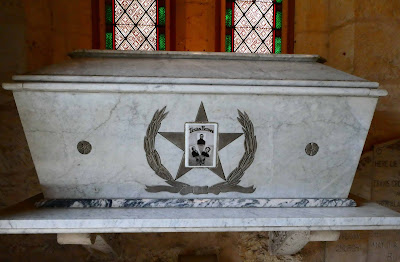And we are in TEXAS!
Once into town, in the River Walk area, there is a much less hectic feel - at least in late Jan! First on my list was the Alamo, Here is the now Cathedral Alamo, sitting across a wide street in downtown San Antonio.
A little closer. As with many historical sights and museums, admission is free!
The story of the Battle of the Alamo in 1836 is a sad one. Texas belonged to Mexico at that time. Determined to gain their freedom and become The Republic of Texas, a group of about 180 men - civilians, military, and rebels from several nations - gathered in the Alamo to fight off approaching Mexican forces who were determined to put down the rebellion once and for all. Eventually a total of about 180 men fought for almost 2 weeks against General Santa Anna and his 5400 troops. Lt. Colonel William Travis, frontiersman Jim Bowie (the Bowie knife guy...), and former congressman and frontiersman Davy Crockett led the TX resistance at the Alamo. Hoping for reinforcements that never came, the "heroes at the Alamo" fought until the last man was either killed or executed .The building has been many things since then, including the current status as a cathedral.
Here is a very comprehensive article about the Battle of the Alamo, events leading up to it, and the eventual capture of General Santa Anna by Sam Houston. Santa Anna agreed to give TX its freedom in exchange for his life.
https://en.wikipedia.org/wiki/Battle_of_the_Alamo
No photos are allowed inside the Alamo Cathedral, but here is a stock photo.
Although the Alamo is now surrounded by city, the original compound has been converted into a nice little park secured by the original walls. The back of the Alamo
The walled area along the side with one of the large Live Oak trees.
It was a dreary and chilly day, but we still opted for the narrated electric riverboat ride on the San Antonio River in the River Walk area. The area has always had aqua-ducts and flow control, but after the September flood of 1921 that put San Antonio under 2-10 feet of water, killing at least 50, the Olso Dam was build. Cutoff channels were still needed. In 1929 visionary architect Robert H.H. Hugman designed a floodgate at the north end of the Great Bend in the river and an adjustable weir at the south end, completely isolating the river area in town from flooding. Commercial development could be done at the river level. Funding was secured after years of debates and the Great Depression. In 1939 the work was begun for the river walk.
Here is a picture of the cute little boats.
It is a nice walking area.
We walked a bit and had lunch before we took our 35 minute ride. Do you think the ducks here are accustomed to being fed??? He came paddling eagerly over to us.
Our ride took us past town
restaurants
and the second tallest observation tower in the US, The Tower of The Americas.
One last visit for our day in San Antonio was a visit to the San Fernando Cathedral. Built in 1749, this is the first church built in San Antonio, the oldest standing church in TX, and one of the oldest cathedrals in the US.
It is very beautiful inside.
Most interesting to me is the fact that the ashes of Travis, Bowie, and Crockett are interned here, along with the ashes of the others who died in the Battle of the Alamo.
Home in the rush hour traffic and ready for a quiet day in the rain. It was relatively quiet until a piece of tooth filling appeared....The amazing dentist in small town Blanco saw me as quickly as I could get there, about 15 minutes. A crown. Another crown.... But this facility is totally high tech, has a 3D printer that makes the crown, and the entire ordeal is done in 3 hours, not 3 weeks! So, a little moving around of campground dates - always fun - and we will be here until Monday noon-ish when the procedure is finished. We will head towards Marathon TX and the Big Bend National Park next!





























































